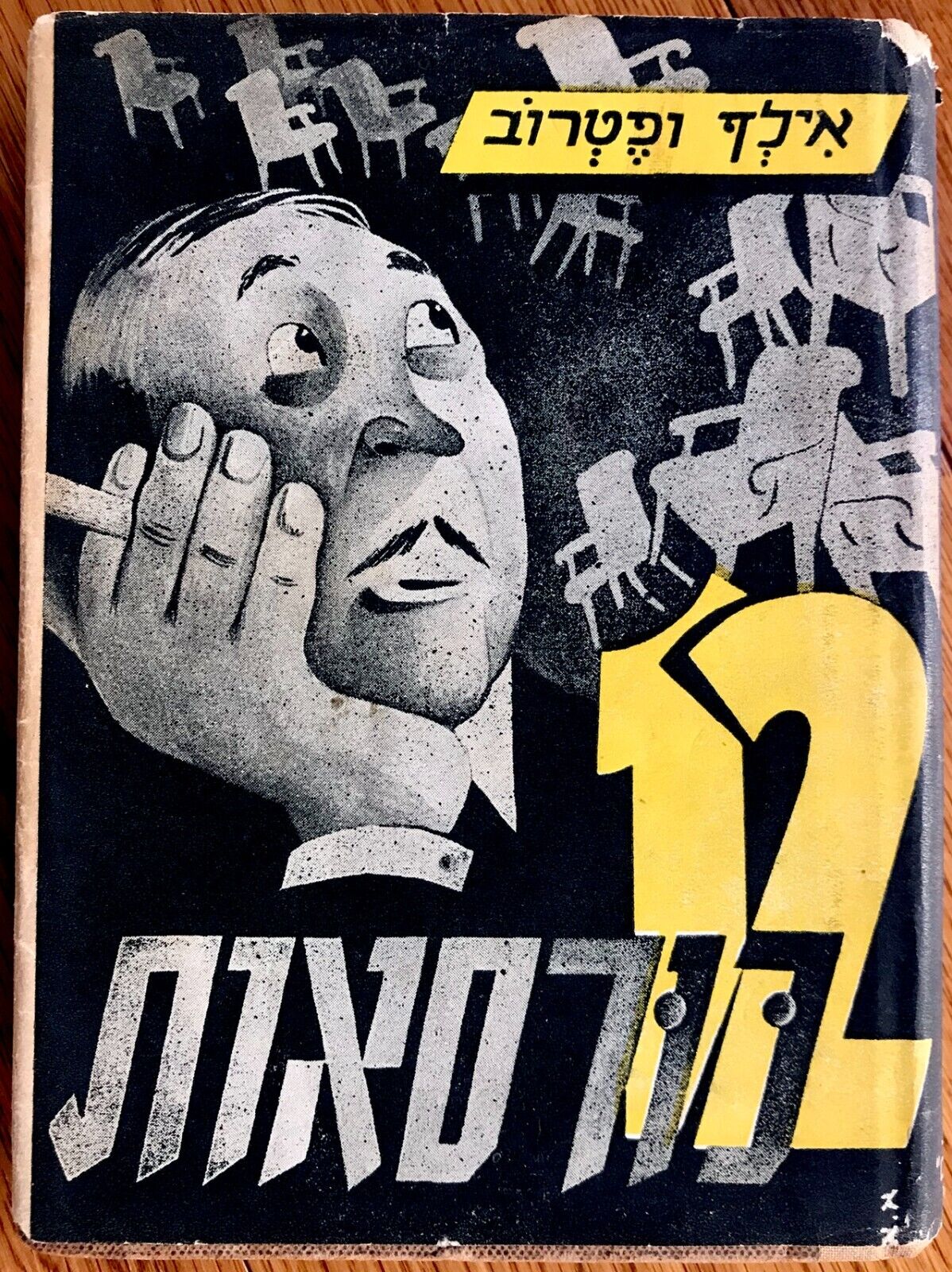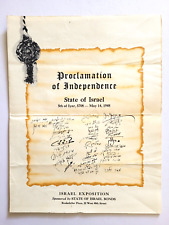When you click on links to various merchants on this site and make a purchase, this can result in this site earning a commission. Affiliate programs and affiliations include, but are not limited to, the eBay Partner Network.
DESCRIPTION : Here for sale is a VERY RARE early HEBREW edition of the RUSSIAN - SOVIET book \"THE TWELVE CHAIRS\" by ILF and PETROV . It was published in 1951 in ISRAEL. The DUST JACKET is being anORIGINALcolorful Jewish - Judaica - Hebrew LITHOGRAPH by the HUNGARIAN JEWISHHOLOCAUST survivor -AHARON ( Irvin ) ABADIfrom BUDAPEST HUNGARY.After his immigration to ERETZISRAEL , After surviving BEGEN BELSEN and the HOLOCAUST in 1950 , ABADI , Both a gifted FIGURATIVE ARTIST and ILLUSTRATOR as well as WRITER , Was one of the most popular ILLUSTRATORS of CHILDREN\'S BOOKS and YOUTH BOOKS , Many of which he has written himself.The magnificently designed LITHOGRAPH was created as a DUST JACKET to the book. This is the FIRST Hebrew edition of the book which was published in 1951 . Book size is around5 x7 \". The DJ as well as the book is intact ( Except of tiny chips to DJ )( Pls look at scan for accurate AS IS images ) . Will be sent in a protective rigid sealed packaging.AUTHENTICITY : Thisis anORIGINALvintage 1951 lithograph , NOT a reproduction or a reprint , Itholds alife long GUARANTEE for its AUTHENTICITY and ORIGINALITY.PAYMENTS : Payment method accepted : Paypal .
SHIPPMENT : Shipp worldwide via registered airmail is $ 25.Will be sent rolled in a special protective rigid sealed package. Handling around 5 days after payment.
More faithful to the original text and its deeply resonant humor, this new translation of The Twelve Chairs brings Ilf and Petrov\'s Russian classic fully to life. The novel\'s iconic hero, Ostap Bender, an unemployed con artist living by his wits, joins forces with Ippolit Matveyevich Vorobyaninov, a former nobleman who has returned to his hometown to look for a cache of missing jewels hidden in chairs that have been appropriated by the Soviet authorities. The search for the chairs takes them from the provinces of Moscow to the wilds of the Transcaucasus mountains. On their quest they encounter a variety of characters, from opportunistic Soviet bureaucrats to aging survivors of the old propertied classes, each one more selfish, venal, and bungling than the last. A brilliant satire of the early years of the Soviet Union, as well as the inspiration for a Mel Brooks film, The Twelve Chairs retains its universal appeal..****** The Twelve Chairs (Russian: Двенадцать стульев, tr. Dvenadtsat stulyev) is a classic satirical novel by the Odesan Soviet authors Ilf and Petrov, published in 1928. Its plot follows characters attempting to obtain jewelry hidden in a chair. A sequel was published in 1931. The novel has been adapted to other media, primarily film.Contents1 Plot2 Legacy2.1 Sequel3 Adaptations4 See also5 Notes6 References7 External linksPlotGeneral view of The Twelve Chairs monument, in Odessa.In the Soviet Union in 1927, a former Marshal of Nobility, Ippolit Matveyevich \"Kisa\" Vorobyaninov, works as the registrar of marriages and deaths in a sleepy provincial town. His mother-in-law reveals on her deathbed that her family jewellery was hidden from the Bolsheviks in one of the twelve chairs from the family’s dining room set. Those chairs, along with all other personal property, were taken away by the Communists after the Russian Revolution. Vorobyaninov wants to find the treasure. The “smooth operator” and con-man Ostap Bender forces Kisa to become his partner, as they set out to find the chairs. Bender\'s street smarts and charm are invaluable to the reticent Kisa, and Bender comes to dominate the enterprise.The \"conсessioners\" find the chairs, which are to be sold at sale in Moscow. They fail to buy them and learn that the chairs have been split up for resale individually. Roaming all over the Soviet Union in their quest to recover the chairs, they have a series of comic adventures, including living in a students\' dormitory with plywood walls, posing as bill painters on a riverboat to earn passage, bamboozling a village chess club with promises of an international tournament, and traveling on foot through the mountains of Georgia. Father Fyodor (who had known of the treasure from the confession of Vorobyaninov\'s mother-in-law), their obsessed rival in the hunt for the treasure, follows a bad lead, runs out of money, ends up trapped on a mountain-top, and loses his sanity. Ostap remains unflappable, and his mastery of human nature eliminates all obstacles, but Vorobyaninov steadily deteriorates.They slowly acquire each of the chairs, but no treasure is found. Kisa and Ostap finally discover the location of the last chair. Vorobyaninov murders[a] Ostap to keep all the loot for himself, but discovers that the jewels have already been found and used to build the new public recreation center in which the chair was found, a symbol of the new society. Angered, Vorobyaninov loses his sanity.LegacySequelMain article: The Little Golden CalfOstap Bender reappears in the book\'s sequel The Golden Calf, despite his apparent death in The Twelve Chairs.AdaptationsThe novel has inspired at least twenty adaptations in the Soviet Union and abroad:The first cinematic adaptation of the novel is the joint Polish-Czech film Dvanáct křesel (1933). The original plot was considerably altered, yet many following adaptations were primarily based on this film rather than on the novel itself (e.g., the former marshal of nobility from the novel was replaced in the Polish-Czech film by a barber who then appeared in several later adaptations).In England, the book inspired the film Keep Your Seats, Please (1936), directed by Monty Banks at Ealing Studios and starring George Formby. The action takes place in Britain and involves seven chairs, not twelve.In Nazi Germany, the film Thirteen Chairs (1938) is based on the novel. However, the film does not credit the novel\'s authors.Dmitri Shostakovich\'s unfinished operetta The Twelve Chairs (1939) is based on the novel.[1]In Hollywood, the comedy It\'s in the Bag! (1945) starring Fred Allen is very loosely based on the novel, using just five chairs.A Brazilian version called Thirteen Chairs (1957) stars comedians Oscarito, Renata Fronzi, and Zé Trindade. In this version, the main character, played by Oscarito, inherits his aunt\'s mansion, which is soon confiscated, leaving him with only 13 chairs. After selling them, he finds out that his aunt had hidden her fortune in the chairs. He then goes on a quest to get the chairs back.Tomás Gutiérrez Alea made a Cuban version titled Las Doce Sillas (1962) with Reynaldo Miravalles as Ostap. Set in a tropical context, in this version the hero \"sees the light\", becomes corrected and joins Cuban revolutionary youth in zafra campaign (sugar cane harvesting).[2]The story also served as the basis for the 1969 film The Thirteen Chairs starring Sharon Tate.A Syrian TV series entitled Hamam al-Hana (1968) is based on the premise of this novel. It involves three guys looking for the hidden treasure (a stash of money) all over Damascus, with a chair for every episode. In the last episode, they find the right chair, but the treasure turns out to be old paper money which by then had become useless.Mel Brooks made a version titled The Twelve Chairs (1970), following the novel more closely, but with a happier ending. Frank Langella plays the part of Ostap Bender, Ron Moody plays Vorobyaninov, and Dom DeLuise plays Father Fyodor.In the 1970s, two adaptations were made in the USSR: a film in 1971 by Leonid Gaidai with Archil Gomiashvili as Bender and a miniseries in 1976 by Mark Zakharov with Andrei Mironov as Bender. ******* Ilya Ilf (Ilya Arnoldovich Feinsilberg or Russian: Илья Арнольдович Файнзильберг, 1897–1937) and Yevgeny Petrov (Yevgeniy Petrovich Katayev or Russian: Евгений Петрович Катаев, 1902–1942) were two Soviet prose authors of the 1920s and 1930s. They did much of their writing together, and are almost always referred to as \"Ilf and Petrov\". They were natives of Odessa.Contents1 Publications2 Script authors3 In culture4 Bibliography5 Notes and references6 External linksPublications[edit]Ilf and Petrov gained a high profile for their two satirical novels: The Twelve Chairs (1928) and its sequel, The Little Golden Calf (1931). The two texts are connected by their main character, Ostap Bender, a con man in pursuit of elusive riches. Both books follow exploits of Bender and his associates looking for treasure amidst the contemporary Soviet reality. They were written and are set in the relatively liberal era in Soviet history, the New Economic Policy of the 1920s. The main characters generally avoid contact with the apparently lax law enforcement. Their position outside the organized, goal-driven, productive Soviet society is emphasized. It also gives the authors a convenient platform from which to look at this society and to make fun of its less attractive and less Socialist aspects. These are among the most widely read and quoted books in Russian culture. The Twelve Chairs was adapted for ca. twenty movies; in the Soviet Union (by Leonid Gaidai and by Mark Zakharov), in the US (in particular by Mel Brooks) and in other countries.From the late 1920s to 1937, the co-authors wrote several theatrical plays and screenplays, as well as many humorous short stories and satirical articles in the magazines Chudak, 30 days, Krokodil and Ogoniok; and the newspapers Pravda and Literaturnaya Gazeta. In the first years of joint creativity Ilf and Petrov published their stories and satires under parodic pseudonyms: Tolstoevsky (composed of the names of writers Tolstoy and Dostoevsky), Don Busilio (from Don Basilio, a character in the opera The Barber of Seville, and the Russian verb busa – scandal, noise), Cold philosopher and others.[1]The two writers also traveled across the Great Depression-era United States. Ilf took many pictures throughout the journey, and the authors produced a photo essay entitled \"American Photographs\", published in Ogoniok magazine.[2] Shortly after that they published the book Одноэтажная Америка (literally: \"One-storied America\"), translated as Little Golden America[3] (an allusion to The Little Golden Calf). The first edition of the book did not include Ilf\'s photographs. Both the photo essay and the book document their adventures with their characteristic humor and playfulness. Notably, Ilf and Petrov were not afraid to praise many aspects of the American lifestyle in these works while being highly critical about others. The title comes from the following description.America is primarily a one-and two-storey country. The majority of the American population lives in small towns of three thousand, maybe five, nine, or fifteen thousand inhabitants.Vladimir Nabokov considered them to be \"wonderfully gifted writers\".[4]Ilf died of tuberculosis a few months after their return from the USA. Petrov became a front line correspondent during the Second World War and, after covering the fighting in Sevastopol, was killed when the airplane he was travelling in back to Moscow crashed while flying low to avoid anti-aircraft fire.Script authors[edit]Woman-Sycophant – comic play (1930, – screenplay (1931, “Барак”)[6]Strong Feeling – vaudeville (1933, “Сильное чувство”)[7]Under the Circus Dome – comic play (1934, with Valentin Kataev, “Под куполом цирка”)[8]In culture[edit]The minor planet 3668 Ilfpetrov, discovered by Soviet astronomer Lyudmila Georgievna Karachkina in 1982, is named after them.[9] ***** Ostap Bender is an unemployed con artist living by his wits in postrevolutionary Soviet Russia. He joins forces with Ippolit Matveyevich Vorobyaninov, a former nobleman who has returned to his hometown to find a cache of missing jewels which were hidden in some chairs that have been appropriated by the Soviet authorities. The search for the bejeweled chairs takes these unlikely heroes from the provinces to Moscow to the wilds of Soviet Georgia and the Trans-caucasus mountains; on their quest they encounter a wide variety of characters: from opportunistic Soviet bureaucrats to aging survivors of the prerevolutionary propertied classes, each one more selfish, venal, and ineffective than the one before. **** 5986 / 207











